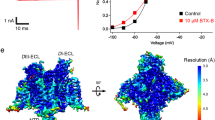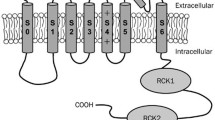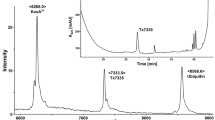Abstract
Batrachotoxinin-A 20-α-benzoate (BTX-B), an analog of the potent depolarizing agent batrachotoxin (BTX), was prepared by selective esterification of naturally occurring batrachotoxinin-A with benzoic acid. BTX-B depolarizes rat phrenic nerve-diaphragm preparations with a time course and concentration dependence virtually indistinguishable from that of BTX. A specific, saturable component of equilibrium binding of [3H]BTX-B to mouse cerebral cortex homogenates was measured, described by an equilibrium dissociation constant of 0.7 µM and a maximum number of binding sites of 90 pmol per gram of tissue (wet weight). Specific binding is inhibited by BTX and other BTX analogs, veratridine, and grayanotoxin but is unaffected by tetrodotoxin and cevine. Under conditions of this assay, neither crude Leiurus quinquestriatus scorpion venom nor purified sea anemone toxin have any effect on specific binding. The data support the conclusion that BTX-B interacts with a recognition site associated with voltage sensitive sodium channels which is identical to the recognition site for BTX.
Similar content being viewed by others
References
Agnew, W. S., Levinson, S. R., Brabson, J. S., and Raftery, M. A. (1978). Purification of the tetrodotoxin-binding component associated with the voltage-sensitive sodium channel fromElectrophorus electricus electroplax membranes.Proc. Natl. Acad. Sci. USA 752606–2610.
Albuquerque, E. X., and McIsaac, R. J. (1970). Fast and slow mammalian muscles after denervation.Exp. Neurol. 26183–202.
Albuquerque, E. X., Warnick, J. E., and Sansone, F. M. (1971). The pharmacology of batrachotoxin. II. Effect on electrical properties of the mammalian nerve and skeletal muscle membranes.J. Pharmacol. Exp. Ther. 176511–528.
Albuquerque, E. X., and Warnick, J. E. (1972). The pharmacology of batrachotoxin. IV. Interaction with tetrodotoxin on innervated and chronically denervated rat skeletal muscle.J. Pharmacol. Exp. Ther. 180683–697.
Albuquerque, E. X., and Daly, J. W. (1976). Batrachotoxin, a selective probe for channels modulating sodium conductances in electrogenic membranes. In Cuatrecasas, P., (ed.),The Specificity and Action of Animal, Bacterial and Plant Toxins (Receptors and Recognition, Series B., Vol. 1), Chapman and Hall, London, pp. 297–338.
Bartels-Bernal, E., Rosenberry, T. L., and Daly, J. W. (1977). Effect of batrachotoxin on the electroplax of electric eel: evidence for a voltage-dependent interaction with sodium channels.Proc. Natl. Acad. Sci. USA 74951–955.
Boegman, R. J., Deshpande, S. S., and Albuquerque, E. X. (1980). Consequences of axonal transport blockade induced by batrachotoxin on mammalian neuromuscular junction. I. Early pre- and postsynaptic changes.Brain Res. 187183–186.
Brown, G. B., and Tieszen, S. C. (1978). Characterization of3H-BTX-B binding to murine cortex.Soc. for Neurosci. Abstracts 4244.
Cahalan, M. D. (1975). Modification of sodium channel gating in frog myelinated nerve fibers byCentruroides sculpturatus scorpion venom.J. Physiol. 244511–534.
Catterall, W. A. (1976). Purification of a toxic protein from scorpion venom which activates the action potential sodium ionophore.J. Biol. Chem. 2515528–5536.
Catterall, W. A. (1977). Activation of the action potential Na+ ionophore by neurotoxins.J. Biol. Chem. 2528669–8676.
Catterall, W. A. and Beress, L. (1978). Sea anemone toxin and scorpion toxin share a common receptor site associated with the action potential sodium ionophore.J. Biol. Chem. 2537393–7396.
Catterall, W. A. (1979). Binding of scorpion toxin to receptor sites associated with sodium channels in frog muscle.J. Gen. Physiol. 74375–391.
Catterall, W. A., Morrow, C. S., and Hartshorne, R. P. (1979). Neurotoxin binding to receptor sites associated with voltage-sensitive sodium channels in intact, lysed and detergent-solubilized brain membranes.J. Biol. Chem. 25411379–11387.
Colquhoun, D., Henderson, R., and Ritchie, J. M. (1972). The binding of labeled tetrodotoxin to non-myelinated nerve fibers.J. Physiol. (Lond.) 22795–126.
Conti, F., Hille, B., Neumcke, W., Nonner, W., and Stämpfli, R. (1976). Conductance of the sodium channel in myelinated nerve fibres with modified sodium inactivation.J. Physiol. 262729–742.
Creveling, C. R., McNeal, E. T., McCulloh, D. H., and Daly, J. W. (1980). Membrane potentials in cell free preparations from guinea pig cerebral cortex: effect of depolarizing agents and cyclic nucleotides.J. Neurochem.,35922–932.
Dorfman, L. M., and Wilzbach, K. E. (1979). Tritium labeling of organic compounds by means of electric discharge.J. Gen. Physiol. 55309–335.
Evans, E. A. (1976). Self-decomposition of radiochemicals: principles, control, observations and effects. Amersham Corporation Review No. 16.
Fatt, P., and Katz, B. (1951). Analysis of the endplate potential recorded with an intracellular electrode.J. Physiol. (Lond.) 115320–370.
Feldman, H. A. (1972). Mathematical theory of complex ligand-binding systems at equilibrium: some methods for parameter fitting.Anal. Biochem. 48317–338.
Hafemann, D. R., and Unsworth, B. R. (1973). Appearance of binding sites for radioactive tetrodotoxin during the development of mouse and chick brain.J. Neurochem. 20613–616.
Hille, B. (1968). Pharmacological modifications of the sodium channels of frog nerve.J. Gen. Physiol. 51199–219.
Huang, M., Shimizu, H., and Daly, J. W. (1972). Accumulation of cyclic adenosine monophosphate in incubated slices of brain tissue. 2. Effects of depolarizing agents, membrane stabilizers, phosphodiesterase inhibitors and adenosine analogs.J. Med. Chem. 15462–466.
Jacques, Y., Fosset, M., and Lazdunski, M. (1978). Molecular properties of the action potential Na+ ionophore in neuroblastoma cells.J. Biol. Chem. 2537383–7392.
Khodorov, B. J., and Revenko, S. V. (1979). Further analysis of the mechanism of action of batrachotoxin on the membrane of myelinated nerve.Neurosci. 41315–1330.
Koppenhöfer, E., and Schmidt, H. (1968). Die Wirkung von Skorpiongift auf die Ionenströme des ranvierschen Schnürrings. II. Unvollständige Natrium-Inactivierung.Pflügers Arch. Eur. J. Physiol. 303150–161.
Levinson, S. R., and Ellory, J. C. (1973). Molecular size of the tetrodotoxin binding site estimated by irradiation inactivation.Nature New Biol. 245122–123.
Matthews, J. C., Albuquerque, E. X., and Eldefrawi, M. E. (1979). Influence of batrachotoxin, veratridine, grayanotoxin I and tetrodotoxin on uptake of Na-22 by rat brain membrane preparations.Life Sci. 251651–1658.
Moolenaar, W. H., and Spector, J. (1978). Ionic currents in cultured mouse neuroblastoma cells under voltage clamp conditions.J. Physiol. (Lond.) 278265–286.
Narahashi, T., Moore, J. W., and Scott, W. R. (1964). Tetrodotoxin blockade of sodium conductance increase in lobster giant axons.J. Gen. Physiol. 47965–974.
Narahashi, T., Shapiro, B. I., Deguchi, T., Scuka, M., and Wang, C. M. (1972). Effects of scorpion venom on squid axon membranes.Am. J. Physiol. 222850–857.
Ray, R., Morrow, C. S., and Catterall, W. A. (1978). Binding of scorpion toxins to receptor sites associated with voltage-sensitive sodium channels in synaptic nerve ending particles.J. Biol. Chem. 2537307–7313.
Ritchie, J. M., and Rogart, R. B. (1977). Density of sodium channels in mammalian myelinated nerve fibers and nature of the axonal membrane under the myelin sheath.Proc. Natl. Acad. Sci. USA 74211–215.
Romey, G., Abita, J. P., Schweitz, H., Wunderer, G., and Lazdunski, M. (1976). Sea anemone toxin: a tool to study molecular mechanisms of nerve conduction and excitation-secretion coupling.Proc. Natl. Acad. Sci. USA 734059.
Schmidt, H., and Schmitt, O. (1974). Effect of aconitine on the sodium permeability of the node of Ranvier.Pflügers Arch. 349133–148.
Seyama, I., and Narahashi, T. (1973). Increase in sodium permeability of squid axon membranes byα-Dihydrograyanotoxin II.J. Pharmacol. Exp. Ther. 184299–307.
Sundermier, H., Dolly, J. O., Albuquerque, E. X., Brown, G. B., Burgermeister, W., Daly, J., and Witkop, B. (1976). Radioactive batrachotoxin derivatives as probes of sodium channel components in electrogenic membranes.Soc. for Neurosci. Abstracts 2419.
Tokuyama, T., Daly, J., and Witkop, B. (1969). The structure of batrachotoxin, a steroidal alkaloid from the Columbian arrow poison frog,Phyllobates aurotaenia, and partial synthesis of batrachotoxin and its analogs and homologs.J. Am. Chem. Soc. 913931–3938.
Ulbricht, W. (1969). The effect of veratridine on excitable membranes of nerve and muscle.Ergeb. Physiol. Biol. Chem. Exp. Pharmakol. 6118–71.
Warnick, J. E., Albuquerque, E. X., and Sansone, F. M. (1971). The pharmacology of batrachotoxin. I. Effects on the contractile mechanism and on neuromuscular transmission in mammalian skeletal muscle.J. Pharmacol. Exp. Ther. 176497–510.
Warnick, J. E., Albuquerque, E. X., Onur, R., Jansson, S.-E., Daly, J., Tokuyama, T., and Witkop, B. (1975). The pharmacology of batrachotoxin. VII. Structure-activity relationships and the effects of pH.J. Pharmacol. Exp. Ther. 193232–245.
Warnick, J. E., Albuquerque, E. X., and Diniz, C. R. (1976). Electrophysiological observations on the action of the purified scorpion venom, tityus toxin, on nerve and skeletal muscle of the rat.J. Pharmacol. Exp. Ther. 198155–167.
Weigele, J. B., and Barchi, R. L. (1978). Saxitoxin binding to the mammalian sodium channel.FEBS Lett. 9549–53.
Author information
Authors and Affiliations
Additional information
This work was supported by a grant from the Alabama Affiliate of the American Heart Association and a NIH grant NS 15617 to G.B.B. and by USPHS grant NS-12063 and Army research office grant 29-78-G-0203 to E.X.A.
Rights and permissions
About this article
Cite this article
Brown, G.B., Tieszen, S.C., Daly, J.W. et al. Batrachotoxinin-A 20-α-benzoate: A new radioactive ligand for voltage sensitive sodium channels. Cell Mol Neurobiol 1, 19–40 (1981). https://doi.org/10.1007/BF00736037
Received:
Accepted:
Issue Date:
DOI: https://doi.org/10.1007/BF00736037




